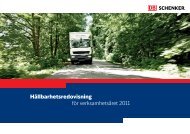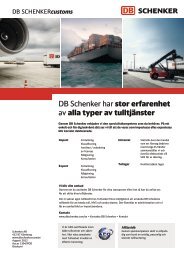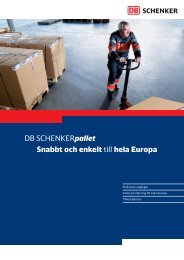PDF Download - Schenker
PDF Download - Schenker
PDF Download - Schenker
Create successful ePaper yourself
Turn your PDF publications into a flip-book with our unique Google optimized e-Paper software.
GRI<br />
LA11<br />
DB <strong>Schenker</strong>’s annual employee satisfaction survey (NMI) – a valuable<br />
source of information in the follow-up process.<br />
The new model for the employee survey (NMI) introduced in 2007, is a<br />
valuable source of information and a supplement in the follow-up of,<br />
among other things, work focusing on the working environment and equality.<br />
It contributes to complementing statistics and core indicators with a<br />
more qualitative description of the conditions. The survey contains a range<br />
of different questions linked to the working environment and working<br />
conditions and presents the employees’ views in areas such as corporate<br />
culture/values, leadership, skills development and the potential to combine<br />
work and being a parent. Personal experience of possible discrimination<br />
and harassment is also sought.<br />
In this year’s employee survey, which refers to conditions in 2010, a new<br />
question regarding foreign origin was added to the background questions.<br />
This information is necessary in order to be able to follow up the results<br />
of our ambition to increase ethnic diversity. The definition of the concept<br />
is taken from Statistics Sweden: Persons born abroad or persons born in<br />
Sweden with two parents born abroad.<br />
The results show that of the 85% of the employees who took part in the survey,<br />
13% state that they have a foreign background, 18% of the blue-collar<br />
workers and 9% of the white-collar workers. One in 10 of DB <strong>Schenker</strong>’s<br />
female white-collar workers had a foreign background, whilst the figure for<br />
men was slightly lower – 8%. Among the blue-collar workers, where the<br />
proportion of women is very low, a foreign background is more common<br />
among the men.<br />
Employee Satisfaction Index<br />
The question methodology in the employee survey is two-dimensional and<br />
is based on the principle of not only asking how good the employer is in<br />
the different areas but also how important each part is to the employee.<br />
Each question is therefore asked from two perspectives – how important<br />
and how well – and the answers are placed on a five-point scale. The gap,<br />
or the difference between the two assessments, i.e. How well minus How<br />
important, provides a measure of the potential for improvement for each<br />
question and each question area.<br />
The higher the minus figure, the lower the “grade”. The best possible result<br />
is zero and is achieved when ‘well’ and ‘important’ concur completely and<br />
produce the same figure, i.e. when the employees’ expectations and wishes<br />
with regard to the employer/working conditions/manager are satisfied<br />
entirely.<br />
–1.5 to –4.0 Very considerable potential for improvement<br />
–1.0 to –1.5 Considerable potential for improvement<br />
–0.5 to –1.0 Certain potential for improvement<br />
Better than –0.5 Small/no potential for improvement<br />
LA11a. Employees with a foreign background<br />
2010<br />
Total Men Women<br />
White-collar workers 9% 8% 10%<br />
Blue-collar workers 18% 18% 12%<br />
Total 13% 14% 10%<br />
Persons with a foreign background = Born abroad<br />
OR born in Sweden with two parents who were born<br />
abroad.<br />
34

















